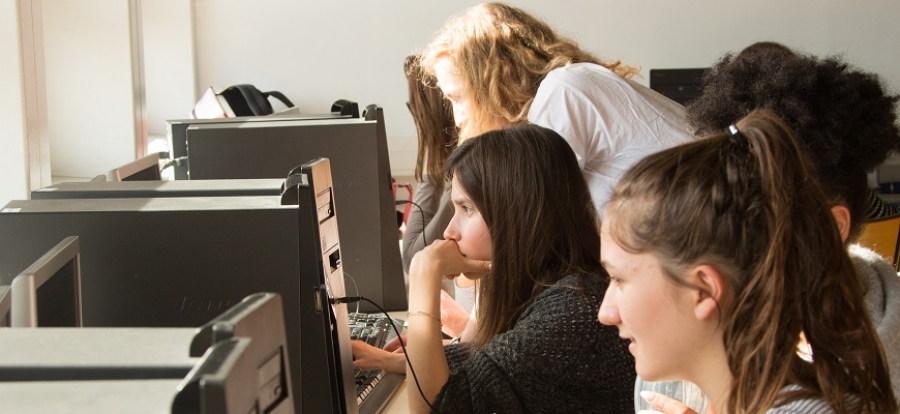Coordinating our school’s online safety provision involves providing day-to-day support to our pastoral team and dealing with child protection concerns, whilst strategically embedding digital citizenship skills and online safety lessons into schemes of work alongside curriculum middle-managers.
eSafety can sometimes be misunderstood, viewed as a new initiative or a ‘bolt-on’ to pastoral care. The reality is that creative and innovative teachers who are bringing new technologies into the classroom, be it virtual reality or video collaboration, have “Innovative teachers have a responsibility to address safe and responsible edtech use.” a responsibility to address safe and responsible use. Teachers using social media to communicate with pupils and the wider community have the unique opportunity to extend their pupils’ learning, demonstrating the wonderful potential that global connectivity can bring, and in doing so, demonstrate what it means to be a digital citizen. Whole-school buy in is essential, and the strategy for online safety should be led from the top with staff afforded time for training, not only in the risks, but in maintaining a professional reputation whilst being users of social media and in encouraging pupils to collaborate in a safe and responsible way.
Reaching out to parents is essential. The online safety messages that the child hears should be consistent across both their school and home life for maximum effect. The reality is that not all parents can speak confidently about issues such as sexting, grooming or trolling to their child. A lack of confidence can deter parents from seeking support for their family. The best piece of advice that I’ve been given is to ‘go to where the parents go’ and to communicate the information in a variety of formats via a number of different mediums - email, newsletter, leaflets, social media channels and information evenings are some of the strategies that we have tried. The latter was one of our relative successes last year.
In my first year in the role, I held an information evening for parents of KS3 pupils. Having poured a great deal of time into the preparation, and we were left feeling slightly deflated when the number of parents in attendance matched the number of staff who had given up their evening to facilitate the event. Last year, we decided to run another parents evening, this time with the added incentive of some tech up for grabs, resulting in over 100 parents in the hall that night. I have heard of schools who have held their talks under the guise of a cooked breakfast, and another who put on a wine and cheese evening. When a school recognises the importance of empowering parents to support their children, a little creativity can go a long way!
But delve a little deeper than the training, the lesson plans and the CP meetings and you’ll soon discover “Not all parents can speak confidently about issues such as sexting, grooming or trolling.”that - at the heart of a school that is successful in implementing effective online safety provision - are pupils who can confidently embrace technology. They are aware of the risks, but also aware of their rights; cognisant of the dangers, but empowered to use technology in creative and collaborative ways. As with all learning, they make some wrong decisions along the way, but let us as teachers lead by example and be there to provide the support when they need us.
Some excellent resources
Professionals Online Safety Helpline:
The nature of online safeguarding means that the types of incidents and the external factors involved affect how the school should respond. This helpline also provides support on dealing with incidents relating to staff and parents.
www.saferinternet.org.uk/professionals-online-safety-helpline
NSPCC Share Aware:
Excellent resources for professionals, parents and carers.
www.nspcc.org.uk/Share/Aware
Vodafone Digital Parenting Magazine:
(Distributed free-of-charge by Parentzone www.parentzone.org.uk/projects/digital-parenting-magazine)
We have distributed three editions of this magazine - a total of 3,300 copies - at no cost to the school. This is a fantastic resource aimed at parents covering everything from gaming to cyberbullying. Also available in digital format.
www.vodafone.com/content/digital-parenting/learning-and-fun/digital-parenting-magazine.html
Childnet Digital Leader programme:
We have worked closely with Childnet over the last few years, and were one of the first schools to embark on their Digital Leader programme. A number of our pupils (spanning all year groups) have completed training modules in online safety and peer support. In the role of Digital Leader they have facilitated pupil workshops, delivered pupil-led education sessions for their peers and parents, and have participated in policy-review.
http://www.childnet.com/our-projects/childnet-digital-leaders-programme/what-people-say
Ineqe H2B Safer Safety Centre:
The H2B Safety Centre provides up-to-date information for staying safe online. After a quick registration, you will have access to videos, prompt cards and other resources and practical advice on how to block, report and configure privacy settings across the most popular apps and games.
www.h2bsafetycentre.com
Ballyclare High School training resources:
At Ballyclare High School we have invested a great deal of time in the development of training resources for staff and educational materials for pupils and parents. Here are a couple of examples:
Parents - http://prezi.com/quorkojfcy_l/?utm_campaign=share&utm_medium=copy&rc=ex0share
Staff - http://prezi.com/pizcr61wfech/?utm_campaign=share&utm_medium=copy&rc=ex0share
I would be happy to share further resources. If interested, please DM me @mrs_hill08.
How do you make eSafety a part of your school? Share your tips below.


















